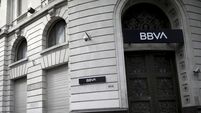Euro area inflation inches toward 2% with focus on June cut

The report adds to evidence that policymakers are on track to return inflation to the 2% target, allowing them to soon dial back some of the restrictions needed after price gains surged into double digits. (AP Photo/Michael Probst, File)
Euro-area inflation slowed more than expected, cementing prospects for an interest-rate cut by the European Central Bank in June.
Consumer prices rose an annual 2.4% last month, down from 2.6% in February, in line with a Bloomberg Economics Nowcast model. Analysts predicted an increase of 2.5%. A measure excluding volatile items such as food and energy also eased more than anticipated, to 2.9%.
The report adds to evidence that policymakers are on track to return inflation to the 2% target, allowing them to soon dial back some of the restrictions needed after price gains surged into double digits. President Christine Lagarde has signalled a first cut in June — informed by fresh forecasts and an update on wage growth in the early months of the year.
Most of the Governing Council — including officials from Germany, France and Spain — have signed up to that timeline, with few clinging to hopes of an earlier move. Economists and money markets are equally aligned, suggesting it would take a big shock to change course.
Traders held wagers on the scope for rate cuts this year after the report, pricing three quarter-point reductions starting in June with the chance of a fourth at around 60%. That compares to as many as four cuts priced ahead of last month’s monetary policy decision.
While shipping disruptions in the Middle East haven’t affected inflation in Europe much and last week’s collapse of a bridge in Baltimore — a key port for carmakers and other manufacturers — is also unlikely to do so, rising pay within the 20-nation eurozone may yet stoke prices.
Chief Economist Philip Lane insists wage increases must continue to retreat for him to consider reversing some of the ECB’s past hikes.
While a key compensation gauge showed some moderation at the end of 2023, salaries continue to expand by more than 4%. That’s sustaining price pressures in services, where labour has an outsized impact on final costs.
Inflation in that sector remained at 4% in March, while the rate for non-energy industrial goods fell to 1.1%.
Across the region, trends also diverge. Spanish inflation accelerated after the government removed some of the support put in place to keep a lid on energy costs, and Italy also saw an uptick. Meanwhile, German and French readings both showed that inflation eased for a third month.
Such trends make it harder to determine the optimal path following the ECB’s initial cut. Policymakers have already shifted some attention to discussing the pace of later steps, though they insist that ultimately economic data will decide.
Lagarde, too, says the ECB will respond to new information as it comes in. “This implies,” she said last month, “that, even after the first rate cut, we cannot pre-commit to a particular rate path.”
Bloomberg.










